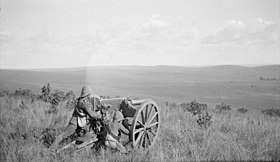Royal Artillery Mounted Rifles
The Royal Artillery Mounted Rifles are detachments of the British Army's Royal Artillery when deployed as mounted infantry. The unit was first developed towards the end of the Second Boer War which was characterised by guerrilla warfare. There was little call for traditional units of field or horse artillery but high demand for mounted infantrymen to counter the highly mobile Boer commandos. By the end of the war around 2,000 artillerymen were acting in the mounted infantry role. A similar force was deployed to Ireland in the early 1920s to counter guerrilla tactics used by Irish republicans.
| Royal Artillery Mounted Rifles | |
|---|---|
 A British pom-pom artillery piece | |
| Active | 1901–1902 |
| Country | |
| Branch | |
| Type | Artillery |
| Role | Mounted infantry |
| Size | Circa 2,000 men |
| Nickname(s) | "Infantillery Corps" |
| Engagements | Second Boer War |
Second Boer War
The final year of the Second Boer War (1899–1902) was characterised by guerrilla warfare fought between mounted Boer commandos and British mobile columns.[1] With little use for heavy calibre weaponry in such an environment both sides stood down much of their artillery units.[2] With a large number of artillerymen gathering at depots awaiting return to England or deployment on garrison duty in India, British commander Lord Kitchener decided to form them into units of mounted infantry.[2] The artillerymen were suited to this task as they were trained to a good standard of horsemanship and tended to be of above average intelligence and discipline.[1][2] Additional rifle shooting practice was arranged for the men, as this was not usually a core aspect of their training.[2][3]
The Royal Artillery Mounted Rifles were formed into independent columns of around 750 men commanded by a Royal Artillery lieutenant-colonel.[2] One such column was commanded by Thomas Baldock, who would later become a Major-General.[4] In addition to mounted infantry the columns contained a light pom-pom artillery unit and their own signals and scout sections.[2] The men were not issued with swords and so relied on rifles with fixed bayonets when required to carry out cavalry-style charges.[5] The units remained under the administration of the Royal Regiment of Artillery who retained responsibility for forming and equipping the units, supply, remounts, staffing and signals.[6]
The columns were particularly active in the final six months of the war during which time they undertook many long distance "drives" to clear the countryside of Boer guerrillas.[1] The units were so successful that Kitchener requested a further 1,000 gunners from the Indian government to deploy in the role; this was refused but a comparable number of artillerymen were instead supplied by the British Army.[2] By the end of the war around 2,000 artillery personnel were serving as mounted infantry.[2]
At the time they were formed, British General Ian Hamilton stated that the artillerymen were keen to carry out their new role.[3] However, Colonel H. Rowan-Robinson, writing in 1921, claimed that the decision was viewed with horror by a large number of the artillerymen due to the unconventional nature of the deployment.[7]
Kipling poem
The unit is commemorated in Rudyard Kipling's 1903 poem Ubique which commemorates the Royal Artillery's service in the war (Ubique is the regimental motto). The poem includes the lines:[8]
Ubique means "More mounted men. Return all guns to store."
Ubique means the R. A. M. R. Infantillery Corps!
This refers to the re-roling of the artillery as a mounted infantry force without their guns. Kipling refers to the unit as "infantillery", a portmanteau of infantry and artillery that he may well have coined, which reflects the role and origins of the unit.[9]
Irish War of Independence
The concept was revived in the early 1920s during and immediately after the Irish War of Independence, another largely-guerrilla war. The bulk of the 30th (Howitzer) Brigade Royal Field Artillery and 36th Brigade Royal Field Artillery, attached to the 5th Infantry Division, were deployed as mounted rifles or else as composite artillery/infantry units. For a brief period in early 1922 they reverted to the traditional artillery role. The I Brigade, Royal Horse Artillery also deployed to Ireland as mounted infantry while the 33rd Brigade Royal Field Artillery operated as a mixed armoured car/infantry unit.[10]
References
- Stirling, John (1903). Our Regiments in South Africa, 1899–1902: Their Record, Based on Dispatches. Edinburgh and London: William Blackwood and Sons. p. 464. Retrieved 4 January 2019.
- Anglesey, Lord (1993). A History of the British Cavalry: Volume 4: 1899–1913. Pen and Sword. p. 221. ISBN 9780436273216. Retrieved 4 January 2019.
- Winrow, Andrew (2016). The British Army Regular Mounted Infantry 1880–1913. Taylor & Francis. p. 140. ISBN 9781317039945. Retrieved 4 January 2019.
- Davis, Frank; Maddocks, Graham (1995). Bloody Red Tabs – General Officer Casualties of the Great War, 1914–1918. London: Leo Cooper. p. 111.
- Rimington, Michael (1912). Our Cavalry. Macmillan. p. Chapter Two. Retrieved 4 January 2019.
- Deputy Director General of Ordnance. "Appendix 1: Record of work carried out by the Artillery Branch of the Headquarter Staff, South African War". Proceedings of the Royal Artillery Institute (30): 7–9. Retrieved 4 January 2019.
- Rowan-Robinson, Colonel H. (1921). "The Danger of Catch-Words and Phrases". Royal United Services Institution Journal. 66 (463): 436. doi:10.1080/03071842109434620.
- "Ubique (Royal Artillery)". The Kipling Society. Retrieved 4 January 2019.
- Hamer, Mary; Ayers, Roger. "Ubique". The Kipling Society. Retrieved 4 January 2019.
- Linderman, A. R. B. (2016). Rediscovering Irregular Warfare: Colin Gubbins and the Origins of Britain's Special Operations Executive. University of Oklahoma Press. p. 29. ISBN 9780806155180. Retrieved 4 January 2019.